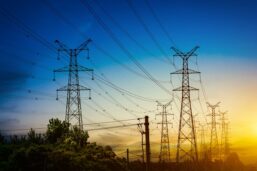Highlights :
- Asia is set to dominate in floating solar, and within that, India.
- It’s important that states which have the right conditions for floating solar grab the opportunity.
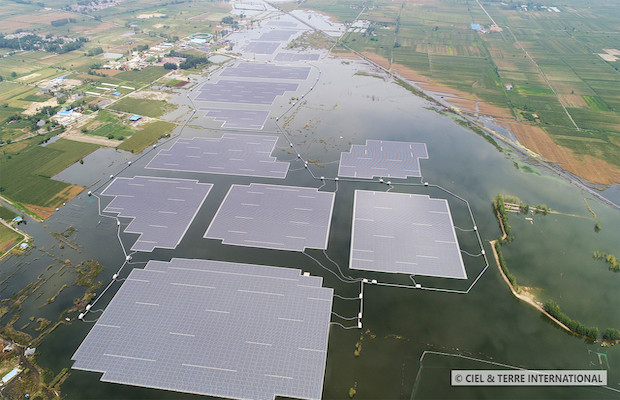
In Solar’s rise to pre-eminence from a fringe renewable energy option just a decade back, it’s time to consider the rise of floating solar (also called floatovoltaics in many cases). To think that it did not even exist at any scale till 2013.
The earliest patent on floating solar was taken out only in 2008. Ciel et Terre, a floating solar specialist based in Lille, France, began pushing the idea back in 2006. In 2007, a small 175 KW commercial plant came up in a pond at Far Niente, a Napa Valley wine producer, to cut energy costs and to avoid using up land where grape vines would deliver higher profits.
The first formal floating PV system was built in 2007 in Aichi, Japan. This was followed by many small, sub MW plants in many countries, notably France, Italy, the Republic of Korea, Spain, and the United States, mostly for research and demonstration purposes. Remember, this was the period when even ‘normal’ solar costs were unviable, and only possible with generous feed in tariffs and direct subsidies. As of now, it seems clear that Asia will dominate floating solar for the near future and beyond.
We picked on floating solar because since the last month, the news has simply not stopped on this younger solar sibling. First was the news of NTPC commissioning a 10 MW floating solar plant at a reservoir used for NTPC’s Simhadri Thermal Plant. The plant is easily the largest existing plant in India, but not for long. This was quickly followed by the inauguration of a 5.4 MW plant in West Bengal by Ciel Et Terre, at Sagardighi, the first one in a thermal plant.
That’s not all. By the time you read this story, NTPC might have inaugurated yet another ‘largest’ floating solar plant for India, the first phase of its 100 MW floating solar plant planned for Ramagundam, in Telangana. Scheduled for a May start, covid disruptions have meant that the PSU will open it up in phases now, of around 15 MW each, to complete the whole 100 MW project by the end of this year. The Rs 423 crore project will eventually cover close to 450 acres of water bodies or reservoirs that serve the Ramagundam thermal plant. Driving this has been a steady drop in Floating solar costs too, as bids came in at Rs 3.29/kWh for a 150 MW floating solar project on Rihand Dam reservoir, in Uttar Pradesh. Won by Shapoorji Pallonji rup and Renew Power. (Note- The project has subsequently been delayed due to issues linked to topography).
Not just that, internationally too, a 60 MW plant was commissioned in Singapore. One of the largest in the world for now, the plant has been built by a subsidiary of Sembcorp Industries on a reservoir, spanning an area of 45 hectares , or 111 acres. Close by in neighbouring Indonesia’s Batam island, Singapore’s Sunseap also announced plans to invest over $2 billion in yet another solar +storage farm, with a peak capacity of 2.3 GW.
Transparency Market Research (TMR), a market intelligence firm, in a March report, has predicted a strong 43 percent CAGR growth for floating solar between 2019 and 2027. TMR also expects innovations and technological advancements to ensure that the growth momentum doesn’t slow in floating solar. The rising adoption of floating solar panels in developing countries like India and China will further boost growth. Of the more than 63+ countries that have announced floating solar projects, close to 40 already have a project that has been commissioned or close to commissioning.
Today, actual installed capacity of floating solar is pushing 3 GW, versus overall solar installed capacity of close to 775 GW. But with the biggest challenge, costs still coming down with larger scale and a better understanding of the technology, floating solar is definitely no longer an option for the future. It has arrived.
Why Floating Solar?
The basic advantages of floating solar are well known. In regions with high population density and competing uses for available land especially, we can see it making inroads now. East India being a prime example. Another advantage being pushed recently is their relevance in large reservoirs built for hydro power, as that places them close to existing electricity transmission infrastructure, even to demand centers like water treatment plants, as seen in the Singapore example. Floating solar installations offer a clear benefit in improved energy yield thanks to the cooling effects of water and the decreased presence of dust. On a 25 year projected life, these advantages help reduce the initial cost difference with ground mounted solar, which start at 10-15 percent usually.
Floating solar, quite simply, fills the need for energy where solar might struggle. In places where getting large land holdings for ground mounted solar is an issue, or by combining with existing resources to make power generation even more effective in the case of reservoirs, be it for thermal or Hydro electric plants.
In case of Hydro plants, the reservoir can actually cut down its hydro power generation during the peak daylight hours, when solar steps in. And then, in non daylight hours, step in to ensure evening peak power requirements. The first such plant was set up in Portugal in 2017, installed by EDP. The feedback so far has been positive, in that output has gone up predictably. At a scale, that means higher grid stabilization and reliability too.
The National Renewable Energy Laborarotory (NREL) in the US has estimated that there are almost 380,000 freshwater hydropower reservoirs across the world that could potentially combine floating PV with existing hydropower facilities. Of course, a full analysis might reveal some that are unfit due to various issues like water levels falling very low to even dead storage in dry season, but there is no doubt that finding areas for installations is not an issue at all. But with a potential power generation capability of almost 7 Terawatts, nothing to sneeze at either.

A relatively lesser discussed benefit is lower O&M costs.
Deepak Ushadevi, Managing Director, Ciet Et terre India informs us that “O&M cost is cheaper (for floating solar) than a ground-mounted system, as there is less soiling due to the water around, plenty of water availability for cleaning. Conventional brush cleaning would be reducing the O&M expenses. During engineering design suite creation, moisture prevention of electrical equipment should be tended to.
All Equipment’s need to be water-resistant and friendly with a moisture environment.”
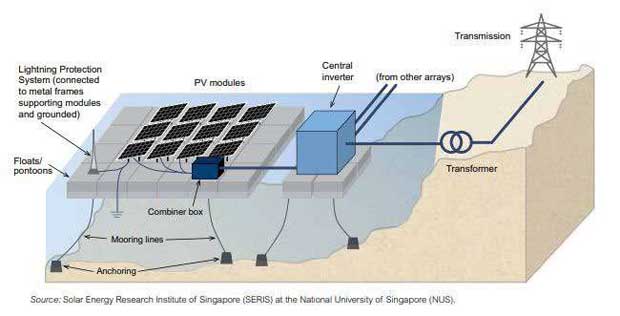
In India, there is a headline target of 10 GW that has been put down for 2022 by the government. Like the overall solar target of 100 GW, this number is unlikely to be achieved. However, with an estimated potential for 280 GW of floating solar in the country, there is zero doubt today that as the early, small floating solar plants build a record of data and performance, floating solar will only grow. As of now, tenders worth 1.7 GW have been issued, even as the consensus estimate is for total floating solar capacity of over 3 GW in India by 2024-25.
Jobs, the extra benefit?
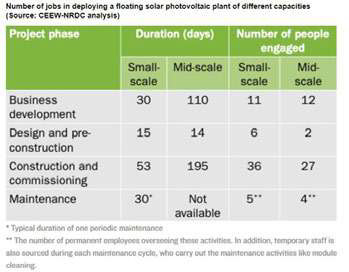
An overlooked aspect of floating solar, which deserves more attention is its impact on jobs. Like rooftop solar, which potentially creates thrice the jobs utility scale solar generates for every MW, floating solar too offers to create the kind of quality jobs that governments like. A study backed by the Natural Resources Defence Council, (NRDC), Council for Energy Environment and Water (CEEW) and Skill Council For Green Jobs (SCGJ) makes the case that floating solar generates more jobs than a ground mounted solar plant. The study’s key findings were:
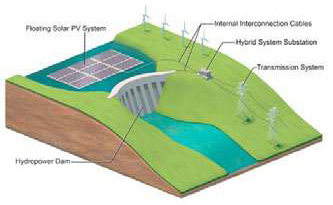
- A small-scale FPV plant (capacity <1MW) directly employs 58 workers while a mid-scale (capacity <10 MW) plant employs 45 personnel, over the course of their deployment.
- FPV generates indirect job opportunities through manufacturers of specialized components like floats, anchors, and mooring system as well as domestic module manufacturers.
- FPV offers opportunities for people qualified in hydraulic engineering, marine architecture, and plastic blow moulding techniques in addition to those required in ground- mounted solar operations.
- By setting time-based targets for FPV capacity, the Indian government can widen the employment potential of this sector, bolster efforts to drive the COVID-19 economic recovery and achieve its Paris Agreement climate goals.
The good news is that like Solar, India has already attracted the key players with experience of floating solar plants. Be it individual equipment suppliers of modules or the inverter suppliers like Sungrow, which is among the key floating structures manufacturer besides its inverters, and Huawei, that is behind some of the world’s largest floating solar plants currently. India has also attracted Ciel Et terre, the leading French floating solar specialist, to set up a subsidiary in India. Headed by Managing Director Deepak Ushadevi in India, the firm has been active for over3 year now, preparing the ground for ever larger projects. Starting from its first project in India, a 452 KWp floating solar plant was installed in Cochin International Airport Limited, the firm recently completed a 5.4 MWp floating solar plant in West Bengal at Sagardighi Thermal Power Plant and a 14.7 MWp project in Thoothukudi for Southern Petrochemical Industries Corporation Limited, which is one of the largest floating solar power projects in India at present. Currently, the firm is installing a mega 75MWp project in South India, adds Ushadevi.
“We have 45+ staff from our HQ in Bangalore & 100+ staff at our manufacturing premises in Kerela, which has a capacity to produce 160 MWp/year of its patented Hydrelio floats by CIEL & TERRE INDIA as part of the Make in India campaign”, Ushadevi informs us.
Challenges for Floating Solar
The Government Hand:
Of all the challenges for floating solar, be it costs, technical, or financing, perhaps the biggest one is related to who will back it. Even as ground mounted solar got a long runway of subsidies, feed in tariffs and much more, besides running on private sector legs, floating solar simply can’t get the same ‘startup’ benefits. However, the good news is, the technology is already catching up fast, and key issues like cost differences, are heading towards manageable levels already.
By its very nature, with most relevant water bodies in control of the government or state owned firms, and other official bodies, floating solar’s biggest challenge is acceptance and adoption by the official system. In a system obsessed with costs, the headway being made by floating solar is strong. Going by the efforts made by NTPC, or the push by state governments of UP (plans for a 200 MW FSP on Rihand Dam) or Madhya Pradesh which has given the go ahead for a 600 MW floating solar plant on Omkareshwar dam, there is enough appreciation for its possibilities.
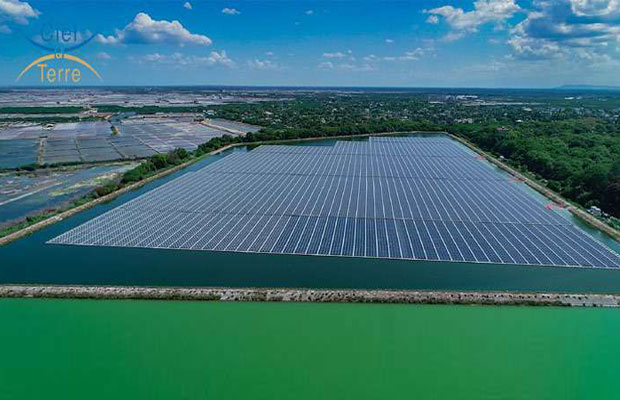
Key energy PSU’s like NHPC, the largest Hydropower operator in the country, or other smaller state undertakings like SJVN and some private sector operators now, have started taking a strong interest and making a push for it. NHPC for now has been allotted the states of Telangana, Odisha, and J&K for development of floating solar power projects under Ultra Mega Renewable Energy Power Parks Schemes of MNRE. The firm has signed an MoU with Odisha for 500 MW on July 20, 2020. The project shall be developed by a JV between NHPC and GEDCOL, which is Green Energy Development Corporation of India Limited. In principal approval has been obtained from MNRE on December 8, 2020 for setting up of 100 megawatt floating solar by the proposed JV Company under Solar Power Park scheme. MoU with Telangana for 500 MW is under consideration for approval.
NHPC was also in the process of development of 50 megawatt floating solar power project in Kerala and 140-megawatt solar park in Odisha. The Telangana plan for a 500 MW Floating Solar Project involves building it in the reservoir of Midmanair Dam that has been proposed under JV Mode with the State Nodal Agency, TSREDCO.
Coal India Limited, (CIL), another PSU with an ambitious 3 GW plan for solar by 2024, came out with a tender in May this year to empanel vendors for its planned floating solar plants. CIl might be taking a leaf out of the experience in China, where collapsed coal mines which had turned into lakes have been converted to floating solar plants in cases. Starting with a 40 MW project in Anhui province, China has set a target of over 1 GW for establishing floating solar on its abandoned coal mines.
All this official attention means that Floating solar finds itself being backed by firms that are well funded, and willing to settle for lower returns even. But with a high risk of delays caused by bureaucratic slowdowns, and procedural issues.
The quality Issue:
By its very nature, floating solar demands higher level of attention to engineering and construction. As Ushadevi asserts, a singular focus on costs can be risky. “The major difference is that, in other developed countries, the selection is purely based on the technology credentials, bankability, and reputation basis. Where as in India, price is the main base. Indian developers and EPCs should be extremely careful while selecting the technology. To reduce risk factors, developers should look for enablers with good raw material, top-class UV stabilizers, good machines to produce quality floaters, QA checks & processes, design suits, design tests & validation, and getting a bankable solution.” he adds.
The increase of 10–15 percent in system costs for floating solar, is mainly due to the floating structures, anchoring and mooring systems that a floating system demands. Development costs are already coming down. Floating systems present specific challenges related to anchoring and mooring them in place, accounting for possible water level variations, the reservoir’s bed type and depth, and extreme weather situations such as high winds and waves. These do drive up engineering and construction costs.
Proximity to water also means higher attention to cable management and insulation testing than on land, especially when cables are in contact with water. Another factor is that a floating solar plant has moving parts that are subject to constant friction and mechanical stress. Systems that are poorly designed and maintained could suffer from catastrophic failures. Floating installations are also at risk of degradation and corrosion due to moisture, especially in more aggressive coastal environments. Appropriate quality standards for the selection of PV components that would survive 25 years in harsh operating environments should be applied. Anchoring serves to spread loads generated by wind and waves to minimize movements of the solar island to avoid the risk of it from hitting the banks or being blown away during storms. Extensive technical studies must be conducted to assess suitable island and anchoring design, overall technical feasibility, and commercial viability of the project.
Long Term Predictions:
NREL estimates 379,068 freshwater hydropower reservoirs across the planet could host combined floating PV sites with existing hydropower facilities. Additional siting data is needed prior to any implementation because some reservoirs may be dry during parts of the year or may not be otherwise conducive to hosting floating PV. The biggest benefit of floating solar- that it doesn’t take up valuable space on land is increasingly becoming more relevant for India. We have already seen how land conflicts between solar parks and issues linked to pastoral lands, habitats for the Great Indian bustard and more have impacted some projects. Even when it comes to floating solar on Hydro project reservoirs, adding generation might actually help obviate the need for at least some of the questionable Hydropower projects that have been planned. NTPC’s Tapovan project in Uttarakhand’s Chamoli district, that suffered extensive damage due to a flash flood recently, is one example. Running over a decade behind schedule and at over 5x of originally projected costs, the generation from the planned run of the river project could be easily done through floating solar at reservoirs of many of the projects the same company is already running.
Ciel Et Terre’s Ushadevi asserts that “with scarcity in the land, land acquisition legal issues & disputes, infinite acquisition delays, floating solar is the perfect solution. We are very much positive that floating solar demand is finally arrived here in India considering water scarcity, water evaporation issues, land issues, and on a positive note plenty of water bodies available. We believe floating solution will be one of the main enablers for the PV sector and we target 1GW Hydrelio solutions to be installed in the upcoming next 2-3 years in India.”
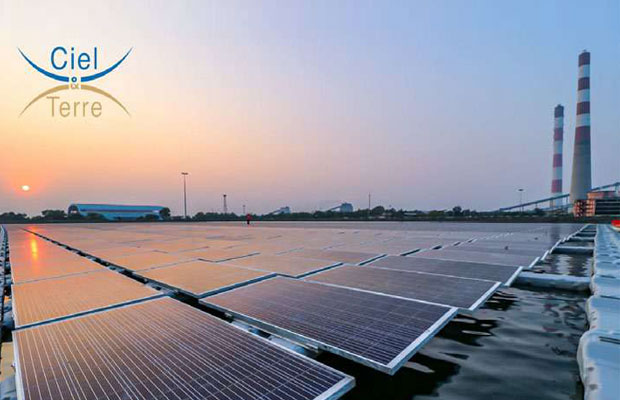
Ciel Et terre’s 5.5 MW Plant at Sagardighi for WBSEDL
He cites the example of West Bengal, otherwise a solar laggard, to make his point. “We have studied a lot of projects in the past in West Bengal and figured their huge potential to develop floating solar projects. West Bengal has many types of water bodies, including dams, irrigation, or water treatment ponds which are ideal for floating projects. Same is the case of Kerala state where plenty of water bodies.”
While all projects so far have been built on freshwater or captive ponds, it’s not that nthing is possible in the seas at all. Ciel Terre Taiwan has commissioned an 88 MWp Changbin project recently, the largest such project on salt water. That required the firm to collaborate with Principia, a leading offshore player to implement & integrate wind and wave design with cost-effective solutions.
It is interesting that even the most aggressive players have taken an early call to desist from building these plants on natural lakes and other water bodies. Firms quote a desire not to risk impacting them without longer experience with floating solar, and also to avoid clashing with the livelihood of fishermen etc. Covering a natural pond with floats means that less sunlight is available for algae to grow which reduces their proliferation. Since a significant part of the water body will be covered or shadowed by the floating PV plant, a reduction of evaporation is expected. But, since both light and heat are expected to decrease, a new balance for the reservoir’s aquatic life is required. Yet, we prefer utilizing artificial water bodies as there is a lesser impact on aquatic life.
Conclusion:
Floating solar has travelled a long way, in a very short time, if one considers the vintage of the larger plants built using the technology. While that means due caution before we jump to make huge assumptions and projections, it does look like we have an option here that will serve to fill a very important gap for solar power. While saving land, and even giving more bang for the buck at our reservoirs. At a time when power purchase from many Hydropower projects is at ell over Rs 3.50/kWh, going upto Rs 6 and more too, there is a very strong case to junk the cost argument against floating solar. A focused approach to building on its initial successes, learning from those, could mean an environmentally less disruptive option as compared to hydro power energy, which frankly has a chequered record in India in recent years. Like mainstream solar, the government also needs to ensure that floating solar does not go the way of rooftop solar, in terms of poor outcomes despite high subsidies. Issues like lack of bathymetric data that assesses depth and topography of water bodies, and other technical and environmental issues need to be addressed urgently to ensure projects awarded actually move ahead. The fate of the large Rihand dam project is a case in point, stuck due to a limited understanding and lack of information on the topography involved there.
Floating Solar also offers a real chance for states across the country, especially those in East India, to rack up some meaningful solar energy installations.







